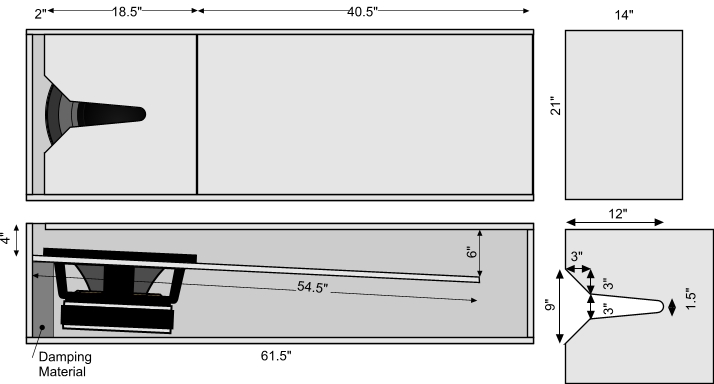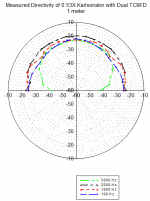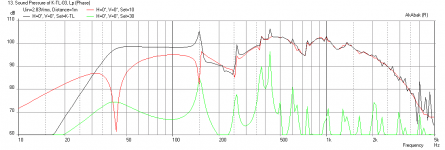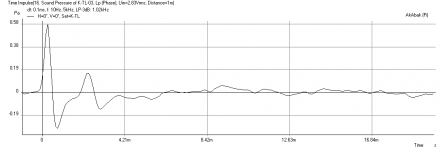The original "classic" Karlson cab was sold mostly as a DIY flatpack which was designed to work with a variety of drivers and on some preconceived (right or wrong) notion of what had WAF.
As charming as it is (jamikl, I'd say more generally mid century modern aka soft googie, rather than Danish furniture design. In fact it looks just as much as something Glenn of California (of Altec Lansing Laguna fame) could have made with its slanted feet), I think it would behove us to reverse engineer the design, understand exactly how it works (and how it doesn't) and separate the different aspects of it from each other.
This, rather than just mindlessly copying the same basic design (somewhat flawed I understand) over and over.
The bandpass with a bass slot-lens over it for better coupling and dispersion at higher frequencies, is pretty well understood and has been implemented in many other designs over the years.
That leaves us with the second and to me most interesting and intriguing feature of the cap: The ability to make large normally very beamy fullrangers (or any not beam, or indeed (if the brochures are to be believed) have close to a 180 degree even dispersion of all frequencies up to ca. 15 kHz.
The usual solution to this has been to put some kind of reflector above (or on the side as with the Paragon) a horizontally mounted driver, with varying success. The reflectors also end up rather big to be effective.
Thinking about, I begin to have the feeling that there is more at play here than just a regular slot. Maybe some edge diffraction is going on like the B&O lens from some years ago:

I'd say there is some similarity.
Some of the dispersion characteristic could simply have to do with the fact that the driver is at an angle or that a coaxial driver was used. But that couldn't lead to the claimed results alone.
So first and formost:
Is there any solid, independent measures of the high frequency dispersion abilities of the Karlson cab. And just as important what does the long time users of the cab have to say about it?
Strangely enough I haven't been able to find either anywhere.
As charming as it is (jamikl, I'd say more generally mid century modern aka soft googie, rather than Danish furniture design. In fact it looks just as much as something Glenn of California (of Altec Lansing Laguna fame) could have made with its slanted feet), I think it would behove us to reverse engineer the design, understand exactly how it works (and how it doesn't) and separate the different aspects of it from each other.
This, rather than just mindlessly copying the same basic design (somewhat flawed I understand) over and over.
The bandpass with a bass slot-lens over it for better coupling and dispersion at higher frequencies, is pretty well understood and has been implemented in many other designs over the years.
That leaves us with the second and to me most interesting and intriguing feature of the cap: The ability to make large normally very beamy fullrangers (or any not beam, or indeed (if the brochures are to be believed) have close to a 180 degree even dispersion of all frequencies up to ca. 15 kHz.
The usual solution to this has been to put some kind of reflector above (or on the side as with the Paragon) a horizontally mounted driver, with varying success. The reflectors also end up rather big to be effective.
Thinking about, I begin to have the feeling that there is more at play here than just a regular slot. Maybe some edge diffraction is going on like the B&O lens from some years ago:

I'd say there is some similarity.
Some of the dispersion characteristic could simply have to do with the fact that the driver is at an angle or that a coaxial driver was used. But that couldn't lead to the claimed results alone.
So first and formost:
Is there any solid, independent measures of the high frequency dispersion abilities of the Karlson cab. And just as important what does the long time users of the cab have to say about it?
Strangely enough I haven't been able to find either anywhere.
Last edited:
Thanks IG81. Yes , that is what I had in mind. Not sure which way the Karlson apertures should face though and am also not sure how to mount a mid or tweeter tube to reflect off the curved surface as the small horn in the Paragon did.
The reason why I am thinking this way is that it looks good and I don't have tin ears. Most of my high frequency hearing has gone so I am not looking for audiophile speakers any more. If what I build does not hurt my ears after extended listening periods and also conveys the emotion in the music, that is good enough for me. A more broad sweet spot would also be good. I guess that places me at odds with most of those who frequent this forum.LOL.
There is also an opportunity with the shape you drew to build a down firing sub between the left and right speakers in the volume behind the curve.
jamikl
The reason why I am thinking this way is that it looks good and I don't have tin ears. Most of my high frequency hearing has gone so I am not looking for audiophile speakers any more. If what I build does not hurt my ears after extended listening periods and also conveys the emotion in the music, that is good enough for me. A more broad sweet spot would also be good. I guess that places me at odds with most of those who frequent this forum.LOL.
There is also an opportunity with the shape you drew to build a down firing sub between the left and right speakers in the volume behind the curve.
jamikl
Funny you should mention Paragon and Karlson together. Look at what I roughly sketched a couple of years back for kicks:
An externally hosted image should be here but it was not working when we last tested it.
IG
Hi. That is a wicked cool idea
Directivity Measurements of Mini Karlsonator with Dual TC9FD
Squeak,
OK, here are the directivity measurements you have been wishing for... My PC sound card craps out at above 8 kHz so I am only presenting results up to 5 kHz. The human vocal range is really only up to 3 kHz and below that range is where 'spatial imaging' is really important for vocals. The measurements were made using a tripod mounted Panasonic WM61A mic capsule mounted at the end of a 12 in long 0.250 in OD aluminum tube, Holmimpulse was used, a ruler was used to set the 1 meter distance for each angle. The measurement height was 50 cm above the floor, speakers were mounted 2.5 cm away from back wall. The data was collected in approximate 10 deg increments and folded to produce 180 deg polar plot. The plot is shown with data at 100 Hz (Blue), 1000 Hz (Red), 2000 Hz (Black), 5000 Hz (Green). As you can see, the performance of the Karlson aperture appears to provide quite an even performance up to 2 kHz, and start having fall-off at 5 kHz when going past 50 deg off-axis. From what I can see, this is consistent with my subjective listening experience that the directivity is very even and has a large sweet spot. It is also consistent with statements made by other Karlson owners that a 100 deg to 120 deg wide HF horn is required to match the pattern of the bass and mids from the K aperture.
Are you closer to being a believer in the effect of a K-aperture on directivity?
So first and formost:
Is there any solid, independent measures of the high frequency dispersion abilities of the Karlson cab. And just as important what does the long time users of the cab have to say about it?
Strangely enough I haven't been able to find either anywhere.
Squeak,
OK, here are the directivity measurements you have been wishing for... My PC sound card craps out at above 8 kHz so I am only presenting results up to 5 kHz. The human vocal range is really only up to 3 kHz and below that range is where 'spatial imaging' is really important for vocals. The measurements were made using a tripod mounted Panasonic WM61A mic capsule mounted at the end of a 12 in long 0.250 in OD aluminum tube, Holmimpulse was used, a ruler was used to set the 1 meter distance for each angle. The measurement height was 50 cm above the floor, speakers were mounted 2.5 cm away from back wall. The data was collected in approximate 10 deg increments and folded to produce 180 deg polar plot. The plot is shown with data at 100 Hz (Blue), 1000 Hz (Red), 2000 Hz (Black), 5000 Hz (Green). As you can see, the performance of the Karlson aperture appears to provide quite an even performance up to 2 kHz, and start having fall-off at 5 kHz when going past 50 deg off-axis. From what I can see, this is consistent with my subjective listening experience that the directivity is very even and has a large sweet spot. It is also consistent with statements made by other Karlson owners that a 100 deg to 120 deg wide HF horn is required to match the pattern of the bass and mids from the K aperture.
Are you closer to being a believer in the effect of a K-aperture on directivity?
Attachments
Post #20
Hi IG81,
I agree w/ Squeak's assessment in Post #26, that the standard Karlson enclosure will not make full use of the Paragon style reflector. Maybe using two Karlson clams pointed at the reflector while maintaining the Paragon style dual low frequency horns, and some JBL slot radiators for the very high frequencies? In other words replace the JBL mid-frequency horns w/ clams?
Regards,
Hi IG81,
I agree w/ Squeak's assessment in Post #26, that the standard Karlson enclosure will not make full use of the Paragon style reflector. Maybe using two Karlson clams pointed at the reflector while maintaining the Paragon style dual low frequency horns, and some JBL slot radiators for the very high frequencies? In other words replace the JBL mid-frequency horns w/ clams?
Regards,
First of all, thank you X for going through all the trouble!
I'd hate to sound ungrateful or be irritating but that isn't better than the regular dispersion pattern of that driver naked, up to 5 kHz.
I have no doubt that Karlson cabs are doing some things right. What I'm not sure of is what?
Maybe what it does to the lower registers changes the perception of the higher somewhat?
Anyhow, I think it is curious how there is absolutely no polar/dispersion measurements to be found anywhere on all the sites praising just the cabs ability to disperse, even the high frequencies.
Not even simple listening observations done on music or test tones are to be found.
That turns on my "pseudo science alarm". Not that I'm against loose empirical observations and tinkering (indeed I'd say that's the real basis of all science and engineering). But at some point solid measurements have to be made.
To be able to share your results to name just one reason.
I'd hate to sound ungrateful or be irritating but that isn't better than the regular dispersion pattern of that driver naked, up to 5 kHz.
I have no doubt that Karlson cabs are doing some things right. What I'm not sure of is what?
Maybe what it does to the lower registers changes the perception of the higher somewhat?
Anyhow, I think it is curious how there is absolutely no polar/dispersion measurements to be found anywhere on all the sites praising just the cabs ability to disperse, even the high frequencies.
Not even simple listening observations done on music or test tones are to be found.
That turns on my "pseudo science alarm". Not that I'm against loose empirical observations and tinkering (indeed I'd say that's the real basis of all science and engineering). But at some point solid measurements have to be made.
To be able to share your results to name just one reason.
Last edited:
But it doesn't use the paragon reflector for anything? How is that cool?
Hi IG81,
I agree w/ Squeak's assessment in Post #26, that the standard Karlson enclosure will not make full use of the Paragon style reflector. Maybe using two Karlson clams pointed at the reflector while maintaining the Paragon style dual low frequency horns, and some JBL slot radiators for the very high frequencies? In other words replace the JBL mid-frequency horns w/ clams?
Regards,
Only a rough sketch and it would indeed be hard to make it work without any kind horn or whatever firing more directly at the reflector. Just one of many half-baked ideas hanging out on my imageshack account.
IG
Squeak,
The sims with bare driver definitely show more pronounced lobes as a function of angle. These were tedious measurements to make and display. Which is probably why no one does it. I won't be making bare driver measurements but know that AkAbak sims show angular dependence 500 Hz and up.
The sims with bare driver definitely show more pronounced lobes as a function of angle. These were tedious measurements to make and display. Which is probably why no one does it. I won't be making bare driver measurements but know that AkAbak sims show angular dependence 500 Hz and up.
Hi xrk971,
That's a great looking graph in Post #27. What does the vertical response look (or sound) like?
Regards,
I have't made vertical measurements but sims show bass is lower and treble higher up as expected. I think sims of vert are somewhere back in kicks butt thread.
My guess would be only B*L or Mms could affect things in the midrange as they do here. It is getting close to 110dB, no way!Does Akabak run any kind of sanity-check on parameter sets?
IG
K alignments are no different than any other, i.e. the lower the Qts, the higher the tuning required and vice versa, so with a published ~311 Hz HF mass corner, the vented cab math says to tune it to ~62 Hz on the low end and centered at ~117 Hz on the high end based on my 6th order BP math for dummies [or ~124 Hz if one uses the old 2:1 R-O-T], which should fill in the big lower mids gap as well as increasing efficiency to a lower F to better match to the driver's rising on axis response.
This greater cab loading will in theory damp some of its HF BW enough to flatten/roll off it somewhat. This will require some serious rigidity though, so FC construction is contraindicated.
Actual bass of course will be minimal as we're always 'robbing Peter to pay Paul', trading efficiency for a wider gain BW.
GM
Karlsoator with Beta 10CX
Has anyone ever tried the Karlsonator with an Eminence Beta 10CX PA driver? This is a really nice powerful driver that seems attractively priced. It will need the coaxial CD for the built in horn, or add a K-tube CD externally. I ran a simulation and adjusted the top channel by increasing it by 1.3X to get more bass amplitude to balance it out a bit. The f3 is 39 Hz (95.6 dB at 1 watt 1 meter), not too bad. If I were to build a full scale K'nator, I think I might go with this driver for a bang for the buck consideration.
First plot is freq response at 1 m, second is impedance, third is cone displacement (well controlled), fourth is impulse response (very clean).
The flat bass shelf on this combo can't be beat (IMO).
Has anyone ever tried the Karlsonator with an Eminence Beta 10CX PA driver? This is a really nice powerful driver that seems attractively priced. It will need the coaxial CD for the built in horn, or add a K-tube CD externally. I ran a simulation and adjusted the top channel by increasing it by 1.3X to get more bass amplitude to balance it out a bit. The f3 is 39 Hz (95.6 dB at 1 watt 1 meter), not too bad. If I were to build a full scale K'nator, I think I might go with this driver for a bang for the buck consideration.
First plot is freq response at 1 m, second is impedance, third is cone displacement (well controlled), fourth is impulse response (very clean).
The flat bass shelf on this combo can't be beat (IMO).
Attachments
fwiw I've run the newer model Beta 10cx in a standard slit-vent K12 and liked it quite a bit. Eminence's crossover values of 2mH/10uF lowpass and 3.3uF/0.35mH highpass work well. The older model Beta 10cx had lower qts. The last B10cx I bought were a bargain at $39.95 each
The original "classic" Karlson cab was sold mostly as a DIY flatpack which was designed to work with a variety of drivers and on some preconceived (right or wrong) notion of what had WAF.
As charming as it is (jamikl, I'd say more generally mid century modern aka soft googie, rather than Danish furniture design. In fact it looks just as much as something Glenn of California (of Altec Lansing Laguna fame) could have made with its slanted feet),
I don't think the Karlson was designed, in the sense that it was a piece of industrial design. AFAIK, the design originates Karlson himself, an engineer, and the form is rather secondary to the function. The dramatic slot was not an aesthetic flourish. The Paragon, on the other hand, was professionally designed in Berkeley, CA by Arnold Wolf, a well known industrial designer.
AFA distinctions between "soft googie", mid-century modern, "Danish modern", etc; these are contemporary categories and distinctions. All of these styles would have been considered "International Style" or simply "modern" at the time.
I think it would behove us to reverse engineer the design, understand exactly how it works (and how it doesn't) and separate the different aspects of it from each other.
This, rather than just mindlessly copying the same basic design (somewhat flawed I understand) over and over.
I fail to see your point. The whole purpose of this design is to do just that. It's not like there's been thousands of people copying this obscure design over and over anyway.
Last edited:
Actual bass of course will be minimal as we're always 'robbing Peter to pay Paul', trading efficiency for a wider gain BW.
GM
Exactly. In the original Karlson design(s), there's an overabundance of gain in the mid to upper bass. Trading some efficiency off to get a wider gain BW was my intent. IOW, Peter actually has a few shekels too many, and Paul is a bit low on funds.
are there virtues to be had with a Karlsonator 15 vs K15? - would it roughly be a 15/12 Karlsonator 12 - or somewhat different? what field of parameters would be desirable for a Karlsonator 15? would it fix the hole seen in the simple type below?

An externally hosted image should be here but it was not working when we last tested it.

Last edited:
- Home
- Loudspeakers
- Full Range
- Karlsonator




